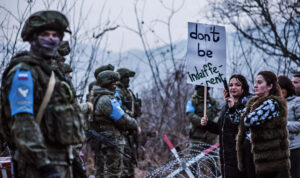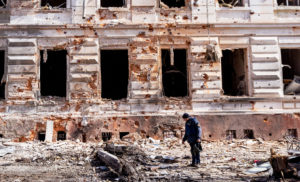One lonely road cuts through the Azerbaijani town of Fuzuli. On one side, a cluster of decaying, vacant houses sit in a dip in the landscape, the remains of the original settlement. Three decades ago, it was home to around 17,000 people. But in August 1993, the entire population, made up of ethnic Azeris, fled. The First Nagorno-Karabakh War was into its final year, and Azerbaijan’s ethnic Armenian separatists, supported by the Republic of Armenia, were approaching. When they arrived in Fuzuli, they completely demolished the town. For the next 27 years, it was devoid of any human life.
But now, on the other side of that lonely road, lies a construction site. “There will be 38 buildings here, with over a thousand apartments,” Araz Imanov, a senior advisor to the Azerbaijani president, tells me. They will provide homes for people internally displaced in the Nineties. The project is part of a huge, government-led reconstruction effort — one that could serve as a blueprint, when the time comes, for the rebuilding of Ukraine.
Even after peace is declared, the scars of war zones make them hard to rebuild. A dozen or so metres from the edge of the road, there are signs warning of the presence of landmines — a legacy of the illegal military occupation of the town, which only ended after the Second Karabakh War in 2020. “That’s why it took us a long time, almost a month, to get in,” Imanov says.
When the authorities finally found safe passage into the town, they discovered houses that no longer had roofs, window frames or doors. They had been torn apart by hand rather than artillery. Everything, down to the copper wiring, was stripped away by occupiers and shipped over the border to Armenia, to be sold as building materials. The most well-preserved building is a former publishing house with an ornate doorway, flanked by two stone columns: a reminder of how culture, and commerce, used to flourish here.
“For 30 years, the Armenians claimed that these territories belonged to them,” says Imanov with a hint of sarcasm. The areas were given new Armenian names, and “their prime minister made statements claiming that they’re not even a separate territory but a part of Armenia itself. Yet this is the way that they treated the lands that they claimed to be their own.”
Azerbaijan’s intentions, however, couldn’t be more different. Cities that were destroyed in the first war will be rebuilt from scratch. Domestic refugees — of which there are 650,000 — will be given fully-furnished homes financed by the state, free of charge. Private sector businesses will be incentivised to invest in what the Azerbaijanis call “the liberated territories” — an area roughly equivalent in size to the state of Qatar — with tax breaks and customs duty exemptions. Dubbed “The Big Return”, this is a huge nation-building mission comparable to Roosevelt’s New Deal.
Already, the progress made since the end of the war is remarkable. In April, when I visited Karabakh, only the skeletal outlines of the new apartment blocks had begun, but on the edge of town, the glistening Fuzuli International Airport is already in operation. Construction began just two months after the end of the Second Karabakh War, in January 2021; by September that year, it had already accommodated its first test flight. Meanwhile, hundreds of miles of newly-asphalted roads have been built in the formerly occupied territories. A railway linking Karabakh to the capital, Baku, which sits on the shores of the Caspian Sea, is already under construction.
The largest urban settlement in the liberated territories is Aghdam. Before the First Karabakh War, it was home to around 37,000 mostly ethnic Azeri population people. Nowadays, it’s known as “the Hiroshima of the Caucasus”, because it looks like it’s been hit by a nuclear bomb. The Azerbaijani government plans to rebuild the town from the ground up because the ruination is so total that there is nothing left to salvage. The same is true of Ukrainian cities including Bakhmut and Mariupol, which might one day be inspired by The Big Return.
Before anything can be built on newly liberated land, though, that land needs to be free of explosives. Decades of military occupation by Armenian forces turned south-western Azerbaijan into one of the most heavily landmined territories on the planet; according to the Halo Trust, “there have been more landmine accidents per capita in Karabakh than anywhere else in the world”. However, Ukraine is now in danger of taking this unfortunate title. Last September, the Ukrainian government estimated that 160,000km2 of land may be “contaminated” by landmines and other unexploded ordnance — an area more than 13 times the size of the entire liberated territories of Azerbaijan.
“After the war, people wanted to go back to see their villages or visit cemeteries, and this is when the majority of [landmine] accidents happened,” says Samir Poladov, the deputy chairman of the Azerbaijan National Agency for Mine Action [ANAMA]. Founded in 1998, the agency both trains minesweepers and teaches the local population to avoid landmines, using everything from dogs to drones to locate them, Soon, it will begin using giant African rats, which have been trained to sniff out explosive substances.
Yet even with all of these cutting-edge methods, the mine-clearing process is incredibly slow, because the Armenians have largely failed to supply Azerbaijan with maps marked with their locations. “Every square metre might potentially be dangerous,” says Poladov. “The best approach is to be like: okay, everything is mined, the only non-mined territories are the ones that have been cleared.” Azerbaijan reclaimed some 11,700km2 of territory in 2020 and, in the first year of operations, cleared a little over 500km2 of landmines. For context, de-mining Ukraine at that rate would take over three centuries.
Nevertheless, ANAMA provides a useful model for how Ukraine can deal with its landmine problem once the war is over. As part of the Big Return programme, Azerbaijanis who have been internally displaced since the Nineties, and who wish to return to their former homelands, have the option of applying to the agency for mine clearance training. After they successfully complete it, they are offered jobs with the agency and posted to the liberated territories. “They’re clearing their own land,” says Poladov. “They’re doing this job for themselves.”
The workers are motivated, then, but they are also cheap. “If we didn’t have this agency, our government would have to outsource this to international companies,” says Poladov, “which would be 10 times more expensive.” Instead, Azerbaijan has become a world leader in mine clearance: Poladov regularly shares his expertise at international conferences.
There has been a great deal of debate about how the funds set aside by the European Commission to rebuild Ukraine should be distributed, given the corruption that has plagued the country. Western donors fretting that funds might be misspent by government authorities could alleviate their fears by financing Ukraine’s very own version of ANAMA. Because not only is de-mining the unavoidable first step in the long process of reconstruction, but employing Ukrainians to do it would also help frame national renewal as an empowering, patriotic mission.
Citizens invariably want to help rebuild. “After the war, I felt like I must do something for my country,” a young Azeri teacher tells me. She’s based in the town of Agali, which is located in the deep south-western corner of Azerbaijan, nestled between the borders of Armenia and Iran. It is the first urban settlement in the region to welcome back returnees that had been displaced in the Nineties; the first batch arrived last July. As of April this year, Agali is home to roughly 420 people who make up 86 families, all of which live free-of-charge in the several-dozen houses that have been built here at the state’s expense over the past two years.
The teacher I spoke to is one of the few residents who is not a returnee. She grew up on the other side of the country, in a military family; her patriotic duty drove her to apply for a teaching job in Agali. “People younger than me died [in the war],” she says. “The whole people feel a duty to do something with this land. That’s why we want to come here.”
Agali looks and feels like a plush gated community built around a suburban shopping centre. Driving past street after street of identikit, two-storey houses with white walls and green roofs, visitors will arrive at a centre that includes a well-stocked supermarket, bank and a restaurant serving Azerbaijani classics. Nearby is the school where our tour guide works, built to accommodate 360 students, which opened last September and still smells of freshly laid paint.
“We lived in [the town of] Sumqayit, but we always carried a wish to return to our land,” one man in his early sixties tells me. He’s standing outside his identikit house with his wife and teenage son. “When we finally came back for the first time and received this place, we were moved.” The man’s family were forced to flee in the first war. Since returning, they’ve been employed as drivers for none other than ANAMA: their days are spent ferrying around de-mining experts, their equipment and the scraps of de-fused explosives that get unearthed from the surrounding land.
Rather than simply rebuilding what was once here, state urban planners have taken the opportunity to improve on the past. Agali is fully WiFi connected and entirely energy self-sufficient. Solar panels are fitted to the buildings and a hydroelectric dam has been built on a nearby river. Settlements under construction across the liberated territories will likewise be equipped with green technologies. Azerbaijan is rising from the ashes as a nation of the future, ready for the challenges of the 21st century.
It is a path that Ukraine could follow. Prior to the Russian invasion, the country had been held back by a sclerotic post-Soviet economy. Many Ukrainians have fled to more advanced economies — a million to Germany alone. To entice them to return, and to stem future brain drain, the new Ukraine, built on present-day battlefields, will need to be thoroughly modern. By the time Kyiv is ready to start thinking about making plans, The Big Return to Karabakh should be complete. Then, Azerbaijan’s own hard-won experiences can be put to good use, helping to rebuild a war zone.
Disclaimer
Some of the posts we share are controversial and we do not necessarily agree with them in the whole extend. Sometimes we agree with the content or part of it but we do not agree with the narration or language. Nevertheless we find them somehow interesting, valuable and/or informative or we share them, because we strongly believe in freedom of speech, free press and journalism. We strongly encourage you to have a critical approach to all the content, do your own research and analysis to build your own opinion.
We would be glad to have your feedback.
Source: UnHerd Read the original article here: https://unherd.com/





